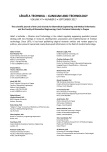RELIABILITY AND SOURCE OF ERRORS IN END-TIDAL GAS CONCENTRATION EVALUATION ALGORITHMS DURING AVALANCHE SNOW AND REBREATHING EXPERIMENTS
During breathing experiments in avalanche snow, measurement of CO2 is often conducted in order to monitor the volunteers or as an endpoint of the trial. From the measured CO2 signal, monitors calculate end-tidal CO2 concentrations (EtCO2). The aim of the study was to investigate several related points: to determine if the Datex-Ohmeda S/5 anesthesia monitor evaluates EtCO2 and other parameters of breathing gas correctly, to characterize the frequency and magnitude of error and to determine the possible cause of the error. Data from a previous experiment aimed at investigation of work of breathing into snow in the presence and absence of an artificial air pocket were used to study accuracy of the monitor. The analysis found that an error of EtCO2 occurred in 39% and in 30% of the total experimental time of breathing, with and without the air pocket respectively (range from 13% to 93% of time). Breathing experiments with simulated snow were conducted in order to find the cause of the error. We determined the error occurs immediately after a significant increase of CO2 in the breathing circuit as a consequence of expired gas rebreathing and is independent of other breathing parameters. The study confirmed that a newer model monitor (CARESCAPE B650) is prone to this error as well. The last experiment conducted with a standard anesthesia machine confirmed, that the error occurs even in a standard clinical setup in the presence of rebreathing. This problem might result in improper actions and could potentially result in harm to a volunteer or a patient.
Keywords:
hypercapnia, EtCO2, avalanche, snow burial, device error, Datex S/5, CARESCAPE B650
Autoři:
Karel Roubík; Jan Filip
Působiště autorů:
Faculty of Biomedical Engineering, Czech Technical University in Prague, Kladno, Czech Republic
Vyšlo v časopise:
Lékař a technika - Clinician and Technology No. 3, 2017, 47, 73-80
Kategorie:
Původní práce
Souhrn
During breathing experiments in avalanche snow, measurement of CO2 is often conducted in order to monitor the volunteers or as an endpoint of the trial. From the measured CO2 signal, monitors calculate end-tidal CO2 concentrations (EtCO2). The aim of the study was to investigate several related points: to determine if the Datex-Ohmeda S/5 anesthesia monitor evaluates EtCO2 and other parameters of breathing gas correctly, to characterize the frequency and magnitude of error and to determine the possible cause of the error. Data from a previous experiment aimed at investigation of work of breathing into snow in the presence and absence of an artificial air pocket were used to study accuracy of the monitor. The analysis found that an error of EtCO2 occurred in 39% and in 30% of the total experimental time of breathing, with and without the air pocket respectively (range from 13% to 93% of time). Breathing experiments with simulated snow were conducted in order to find the cause of the error. We determined the error occurs immediately after a significant increase of CO2 in the breathing circuit as a consequence of expired gas rebreathing and is independent of other breathing parameters. The study confirmed that a newer model monitor (CARESCAPE B650) is prone to this error as well. The last experiment conducted with a standard anesthesia machine confirmed, that the error occurs even in a standard clinical setup in the presence of rebreathing. This problem might result in improper actions and could potentially result in harm to a volunteer or a patient.
Keywords:
hypercapnia, EtCO2, avalanche, snow burial, device error, Datex S/5, CARESCAPE B650
Zdroje
Falk, M., Brugger, H., Adler-Kastner, L.: Avalanche survival chances. Nature 1994; 368 : 21.
[2] Haegeli, P., Falk, M., Brugger, H., Etter, H. J., Boyd, J.: Comparison of avalanche survival patterns in Canada and Switzerland. Canadian Medical Association Journal 2011, 183(7), 789-795.
[3] Boyd, J., Haegeli, P., Abu-Laban, R. B., Shuster, M., Butt, J. C.: Patterns of death among avalanche fatalities: a 21-year review. Canadian Medical Association Journal 2009; 180 : 5: 507-512.
[4] McIntosh, S. E., Grisom, C. K., Olivares, C. R., Kim, H. S, Tremper, B.: Cause of death in avalanche fatalities. Wilderness & Enviro-mental Medicine 2007; 18 : 4: 293-297.
[5] Hohlrieder, M., Brugger, H., Schubert, H. M., Pavlic, M., Ellerton, J., Mair, P.: Pattern and severity of injury in avalanche victims. High Altitude Medicine & Biology 2007; 8 : 1: 56-61.
[6] Brugger, H., Sumann, G., Meister, R., Adler-Kastner, L., Mair, P., Gunga, H. C.: Hypoxia and hypercapnia during respiration into an artificial air pocket in the snow: implications for avalanche survival. Rescuscitation 2003; 58 : 81-88.
[7] Grissom, C. K., McAlpine, J. C., Harmston, C. H., Radwin, M. I., Giesbrecht, G. G., Sholand, M. B. et al. Hypercapnia Effect on Core Cooling and Shivering Treshold During Snow Burial. Aviation, Space, and Environmental Medicine 2008; 79 : 8: 735-742.
[8] Grissom, C. K., Radwin, M. I., Harmston, C. H., Hirshberg, E. L., Crowley, T. J.: Respiration during snow burial using an artificial air pocket. Jama 2000; 283 : 17 : 2261-2271.
[9] Radwin, I. M., Grisom, C. K., Scholand, M. B., Harmston, C. H.: Normal Oxygenetation and Ventilation during Snow Burial by the Exclusion of Exhaled Carbon Dioxine. Wilderness Enviromental & Medicine 2001; 12 : 256–262.
[10] Roubik, K., Sieger, L., Sykora, K.: Work of Breathing into Snow in the Presence versus Absence of an Artificial Air Pocket Affects Hypoxia and Hypercapnia of a Victim Covered with Avalanche Snow: A Randomized Double Blind Crossover Study. PLoS ONE 2015; 10(12): e0144332. doi:10.1371/journal.pone.
0144332.
Štítky
BiomedicínaČlánok vyšiel v časopise
Lékař a technika

2017 Číslo 3
Najčítanejšie v tomto čísle
- DEVELOPMENT OF NEW TECHNIQUE FOR ACCURATE WEAR ANALYSIS OF EXPLANTED TOTAL HIP REPLACEMENTS
- DESIGN OF AN EXPERIMENTAL LASER SPECKLE CONTRAST IMAGING SYSTEM AND IMAGE
- RELIABILITY AND SOURCE OF ERRORS IN END-TIDAL GAS CONCENTRATION EVALUATION ALGORITHMS DURING AVALANCHE SNOW AND REBREATHING EXPERIMENTS
- DETERMINATION OF THE GEOMETRICAL AND VISCOELASTIC PROPERTIES OF SCAFFOLDS MADE BY ADdITIVE MANUFACTURING USING BIOPLOTTER
